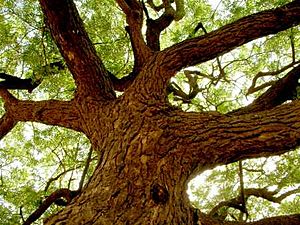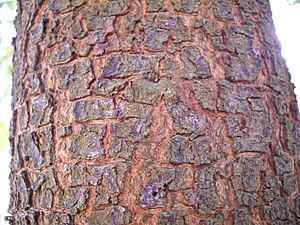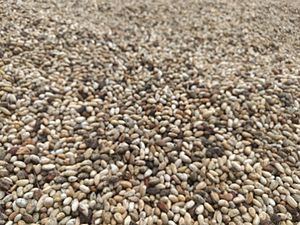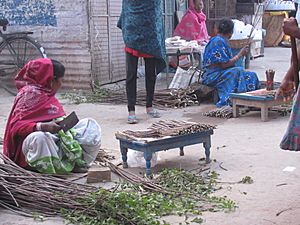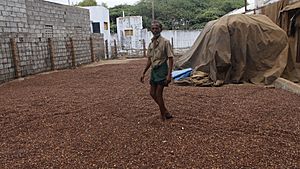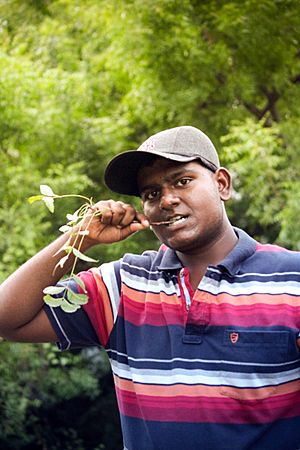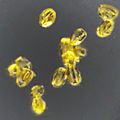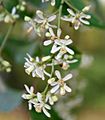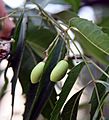Neem facts for kids
Quick facts for kids Azadirachta indica |
|
|---|---|
 |
|
| Azadirachta indica, flowers and leaves | |
| Scientific classification | |
| Kingdom: | |
| Division: | |
| Order: | |
| Family: | |
| Genus: |
Azadirachta
|
| Binomial name | |
| Azadirachta indica |
|
The Neem tree is part of the mahogany family, called Meliaceae. It originally comes from countries like India, Myanmar, Bangladesh, Sri Lanka, Malaysia, and Pakistan. You can find it growing in warm, tropical and semi-tropical areas. It was once the state tree of Hyderabad Deccan.
Neem trees grow very quickly. They can reach heights of 15 to 20 meters (about 50–65 feet). Some even grow as tall as 35 to 40 meters (115–131 feet). These trees are evergreen, meaning they usually keep their leaves all year round.
Contents
About the Neem Tree
The Neem tree is a fast-growing plant. It usually reaches heights of 15 to 20 meters (50–65 feet). Sometimes, it can grow much taller, up to 35 to 40 meters (115–131 feet). It is an evergreen tree. However, if there's a very bad drought, it might lose most or all of its leaves.
The branches of a Neem tree spread out wide. Its crown, which is the leafy top part, is usually round. It can grow to be 20 to 25 meters (65–82 feet) wide. The Neem tree looks a lot like its relative, the Chinaberry tree (Melia azedarach).
Neem leaves grow opposite each other on the branch. They are pinnate, which means they have many small leaflets arranged along a central stem. These leaves are 20 to 40 centimeters (8–16 inches) long. Each leaf has 20 to 31 dark green leaflets. These leaflets are about 3 to 8 centimeters (1–3 inches) long. Often, the very last leaflet at the tip is missing. The small stems that connect the leaflets to the main leaf stem are short.
The Neem tree has white, sweet-smelling flowers. These flowers hang down in clusters called panicles, which can be up to 25 centimeters (10 inches) long. Each cluster can have 250 to 300 flowers. A single flower is small, about 5 to 6 millimeters (0.2 inches) long and 8 to 11 millimeters (0.3–0.4 inches) wide. On the same tree, you can find both male flowers and flowers that have both male and female parts.
The fruit of the Neem tree is smooth and looks like an olive. It is a type of drupe. The fruit can be oval or almost round. When ripe, it is 1.4 to 2.8 centimeters (0.5–1.1 inches) long and 1.0 to 1.5 centimeters (0.4–0.6 inches) wide. The outer skin of the fruit is thin. The pulp inside is yellowish-white, bitter-sweet, and very fibrous. This pulp is about 0.3 to 0.5 centimeters (0.1–0.2 inches) thick. Inside the fruit is a hard, white shell. This shell holds one, or sometimes two or three, long seeds. These seeds have a brown outer layer.
People sometimes confuse the Neem tree with a similar-looking tree called bakain. Bakain also has jagged leaflets and similar fruits. One way to tell them apart is by their leaves. Neem leaves are pinnate (single row of leaflets). Bakain leaves are twice or thrice pinnate (leaflets are divided into smaller leaflets). Also, bakain fruits look like tiny apples.
Uses of Neem
Neem leaves are often dried in India. People place them in cupboards to keep insects away from clothes. They also put them in containers where rice is stored. Neem flowers are used in many Indian festivals, such as Ugadi. In Ayurveda, an ancient Indian medicine system, Neem is also used in special baths.
Neem as a Vegetable
The young shoots and flowers of the Neem tree can be eaten as a vegetable in India. In Tamil Nadu, a soup-like dish called Veppampoo charu is made from Neem flowers. This is also known as "neem flower rasam". In Bengal, young Neem leaves are fried in oil with small pieces of eggplant. This dish is called nim begun. It is often eaten first during a Bengali meal as an appetizer with rice.
Neem is also used in parts of Southeast Asia. This includes Cambodia (where it's called sdov), Laos (kadao), Thailand (sadao or sdao), Myanmar (tamar), and Vietnam (sầu đâu). In Vietnam, it's used to make a salad called gỏi sầu đâu. Even when lightly cooked, the taste is quite bitter. Not everyone in these countries enjoys it, but many believe it is good for health. Neem gum is rich in protein. In Myanmar, young Neem leaves and flower buds are boiled with tamarind fruit. This helps make them less bitter, and they are then eaten as a vegetable. Pickled Neem leaves are also eaten with tomato and fish paste sauce in Myanmar.
Traditional Medicine
For over 2,000 years, products from Neem trees have been used in India for their health properties. People who practice Siddha and Ayurveda believe Neem products can help fight worms, fungi, and bacteria. They also think it can help with diabetes and viruses. Neem is a key part of siddha medicine, Ayurvedic, and Unani medicine. It is often suggested for skin diseases. Neem oil is also used for healthy hair. It is thought to help the liver, clean the blood, and balance blood sugar. Neem leaves have been used to treat skin problems like eczema and psoriasis.
It is important to know that not enough scientific research has been done to fully prove all the benefits of Neem. For adults, using Neem for a short time is generally safe. However, using it for a long time might harm the kidneys or liver. For small children, Neem oil can be very harmful and even dangerous. It is always best to be careful and talk to a doctor before using any traditional remedies.
Pest and Disease Control
Neem is a main part of non-pesticidal management (NPM). This means it offers a natural way to control pests instead of using man-made pesticides. Neem seeds are ground into a powder. This powder is soaked in water overnight. Then, the water is sprayed onto crops. To work well, it needs to be sprayed often, at least every ten days. Neem does not kill insects right away. Instead, it stops them from eating, acts as a repellent, and prevents them from laying eggs. This protects the crop from damage. The insects then starve and die within a few days. Neem also stops pest insects from hatching from their eggs. Fertilizers made with Neem have been good at fighting pests like the Southern armyworm. Neem cake is often sold as a fertilizer.
Neem oil has been shown to stop termite attacks. It is a good, natural, and affordable way to protect against termites.
Construction Use
The juice from the Neem plant is a powerful ingredient for wall plaster. This is mentioned in an ancient Sanskrit book called the Samarāṅgaṇa Sūtradhāra. This book deals with Śilpaśāstra, which is the Hindu science of art and construction.
Other Uses of Neem
- Hair Combs: Combs are handcrafted from Neem wood. People believe that using them regularly can help with hair loss, dandruff, and other scalp issues.
- Toiletries: Neem oil is used to make many beauty products. These include soap, shampoo, balms, creams, and even toothpaste.
- Animal Treatment: Neem is used to treat skin problems like sweet itch and mud fever in horses.
- Toothbrush: Traditionally, thin Neem twigs are used as a toothbrush. People chew on them first. Then, they split the twig to use it as a tongue cleaner. This practice has been used for hundreds of years in India, Africa, and the Middle East. It is still common in rural areas of India. Neem twigs are collected and sold in markets for this purpose. Studies have shown that using Neem twigs can be as effective as a regular toothbrush in reducing plaque and gum problems.
- Tree Benefits: Besides its use in traditional Indian medicine, the Neem tree is very important for fighting desertification. It also helps by absorbing carbon dioxide from the air.
- Neem Gum: Neem gum is used as a thickening agent. It is also used to prepare special types of food.
- Neem Blossoms: In parts of India like Andhra Pradesh, Tamil Nadu, and Karnataka, Neem blossoms are used to make Ugadi pachhadi. This is a mix of Neem flowers and jaggery (unrefined brown sugar). It is given to friends and family. It symbolizes the sweet and bitter events that might happen in the new year, Ugadi. In Karnataka, a curry called "Bevina hoovina gojju" is made with Neem blossoms all year. Dried blossoms are used when fresh ones are not available. In Tamil Nadu, a rasam (veppam poo rasam) made with Neem blossoms is a special dish.
- Cosmetics: In India, Neem is seen as a beauty aid. Powdered Neem leaves are a key ingredient in some facial creams. Pure Neem oil is also used in nail polish and other beauty products.
- Bird Repellent: Water boiled with Neem leaves can be a cheap way to keep birds away. It works especially well for sparrows.
- Lubricant: Neem oil does not dry out easily. It also lasts longer than most other vegetable oils. In rural India, it is often used to grease cart wheels.
- Fertilizer: Neem extract is added to fertilizers like urea. It helps to slow down the process of nitrification, which makes the fertilizer work better.
- Plant Protectant: In Karnataka, people grow Neem trees mainly for their green leaves and twigs. They mix these into flooded rice fields before planting rice seedlings. This helps protect the young rice plants.
- Resin: A sticky substance can be collected from the trunk by cutting the bark. This material is rich in protein. It is not the same as polysaccharide gum, like gum arabic. However, it might be used as a food additive. It is widely used in South Asia as "Neem glue".
- Bark: Neem bark contains 14% tannin. This is similar to the amount found in trees like Acacia decurrens, which are known for their tannin. Also, the bark provides a strong, rough fiber. This fiber is commonly woven into ropes in Indian villages.
- Honey: In some parts of Asia, Neem honey is very valuable. People encourage beekeeping by planting Neem trees.
- Soap: About 80% of India's Neem oil supply is used by soap makers. Much of it goes into small-scale special soaps, often using cold-pressed oil. Large soap companies also use it because it is cheap. Neem oil is also good for soap because it fights bacteria and fungi. It is soothing and moisturizing. Soaps can be made with up to 40% Neem oil. Usually, the raw oil is used to make rough laundry soaps.
- Animal Feed: Neem leaves can sometimes be used as food for animals like cows, goats, and rabbits.
Images for kids
-
A Neem tree in Gambia
See also
 In Spanish: Margosa de la India para niños
In Spanish: Margosa de la India para niños




